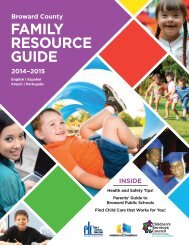Care
1Nbo3qh
1Nbo3qh
- No tags were found...
You also want an ePaper? Increase the reach of your titles
YUMPU automatically turns print PDFs into web optimized ePapers that Google loves.
Babies<br />
sleep<br />
safest:<br />
ALONE<br />
IN A CRIB<br />
ON THEIR BACK<br />
How to Keep Your Baby Safe:<br />
• Make sure the baby’s crib meets Consumer Product Safety Commission<br />
standards.<br />
• The mattress should be firm and fit snuggly in the crib’s frame.<br />
• Crib sheets should fit tightly around the mattress.<br />
• Place baby on his or her back to sleep to reduce the risk of suffocation.<br />
• Keep baby’s sleep area clear of strings, cords and wires.<br />
• Give your baby a pacifier (never a bottle) when he or she goes to sleep.<br />
However, if the baby does not want the pacifier, do not force it into his<br />
or her mouth or reinsert if found the baby has discarded it in his sleep.<br />
• Keep the room temperature comfortable for a lightly clothed adult.<br />
• For the first six months, keep baby’s bed in the same room as his or her<br />
caregiver in order to be attentive to baby’s cries.<br />
• Avoid exposing your baby to smoke both during pregnancy and after<br />
birth, as exposure to smoke is a major risk factor for Sudden Infant<br />
Death (SIDS) and Sudden Unexplained Death Syndrome (SUID).<br />
• Use infant sleep clothing designed to keep your baby warm without the<br />
possible hazard of head covering or entrapment. Infants are typically<br />
comfortable with one layer more than an adult would wear to be<br />
comfortable in the same environment.<br />
How Different Sleep Situations<br />
Can Be Dangerous:<br />
• Although they may look cute, pillows, blankets, bumper pads and toys<br />
can suffocate your infant.<br />
• Despite popular belief, sleep aids such as wedges and sleep positioners<br />
can increase the risk of infant death due to suffocation. If the infant<br />
shifts at all, the soft objects can actually trap the baby in a fatal position.<br />
• Sleeping with your infant may be more convenient and look peaceful,<br />
but the risk of an adult rolling onto or pinning the baby and killing the<br />
infant by suffocation increases immensely through co-sleep.<br />
• Each baby should have its own bed – even multiples and other siblings<br />
increase the risk of suffocation.<br />
• Adult beds, air mattresses, beanbags, reclining chairs, sofas, etc. are not<br />
made for babies and wedge a baby, causing suffocation.<br />
HEALTH & SAFETY<br />
56 For advertising information, please call 1.888.708.5700 ext 12.<br />
• Any loose cables, wires, bumper pad strings, etc. around the crib could be<br />
fire hazards and/or wrap around your baby’s neck and strangle him or her.<br />
• If you do not place your baby on the back to sleep, your baby’s airway<br />
may not be clear.<br />
How to Help Your Baby Sleep<br />
Calmly and Comfortably:<br />
• Give your baby active play time during the day, including “tummy time” that<br />
allows the infant supervised play while lying on their bellies. Tummy time<br />
strengths back, arm and neck muscles, is important for coordination<br />
development and decreases the risk of Flat Head Syndrome.<br />
• You can reduce your baby’s stress by responding quickly to their needs<br />
during the day.<br />
• Putting babies to bed when they start to look tired, but are not asleep,<br />
helps them learn how to fall asleep on their own.<br />
• If your baby seems restless at bedtime, try putting him or her down 30<br />
minutes earlier. Sometimes baby can become fussy and energetic if they<br />
get overtired.<br />
• Have a bedtime routine to allow your baby to wind down (giving a bath,<br />
massaging muscles, spending quite time together, reading a book, etc.).<br />
• Talk or sing softly to your baby before bed. The sound of your voice is<br />
very soothing to your baby.<br />
• Use dark colored shades over windows near your baby’s sleeping area<br />
so no light wakes your baby up.<br />
• Make sure your baby’s nose is clear before bedtime. A cool-mist<br />
humidifier may also help with congestion. Also dust regularly and<br />
remove dust collecting items from the baby’s area.<br />
• If your baby is teething, check with your pediatrician to see what<br />
medications or pain-relieving options may be available.<br />
• Make sure you do not put your baby to bed with a wet diaper. A wet<br />
diaper can cause a baby to wake up.<br />
• Place a warm towel on your baby’s crib sheet and remove it just before<br />
you place your baby down.<br />
For more information, please go to www.myflfamilies.com/serviceprograms/child-welfare/safesleep.<br />
■<br />
Information provided by the Florida Department of Children and Families



